Unlock your genetic potential or gift the power of personalized health. Browse our Supersaver Packs now.
Waking up at the same time every day? Consistent and prolonged awakenings can be due to factors other than your environment. Underlying sleep disorders, uncontrolled stress or anxiety, aging, and hormonal imbalances could result in waking up at the same time every day. We'll explore these and other potential causes, including genetics, and how to fix it.
Nocturnal awakenings, or waking up in the middle of the night, are relatively common. Many awakenings even go unnoticed as most people fall back asleep quickly.
According to the Sleep Foundation, more than 35% of people wake up during the night at least three times a week.
Environmental disturbances such as traffic noise, a partner snoring, room temperature changes, etc., can wake you up while you’re sleeping. However, in most cases people fall back asleep very quickly.
When awakenings occur very frequently or at the same time every day, or if you struggle to go back to sleep when awakened, it may indicate an underlying problem.
Several factors can contribute to why you randomly wake up in the middle of the night.
People go through four stages of sleep, with each cycle lasting between 90-120 minutes.
The third stage of sleep, called the slow-wave sleep, is the deepest stage. The fourth stage is characterized by rapid eye movement, commonly called REM sleep.
Sleep experts suggest that at this stage, brain activity is almost as high as it is when awake.
Awakenings typically happen after this, and when you fall back asleep, the cycle restarts.
Hence, if you typically sleep around the same time, these awakenings can happen at the same time.
Several sleep disorders like insomnia, restless leg syndrome, and sleep apnea can result in difficulty falling asleep, difficulty staying asleep, or random sleep interruptions.
Stress and anxiety activate the body’s fight-or-flight response.
This heightened state of arousal can lead to increased heart rate and muscle tension, making it harder to stay asleep.
Stress can disrupt your circadian rhythm, leading to a pattern of waking up at the same time nightly.
As people age, their circadian rhythms often shift forward, leading to earlier bedtimes and wake times. This is known as advanced sleep phase syndrome.
Older adults experience more fragmented sleep, which contributes to increased awakenings throughout the night.
Further, age-related chronic conditions like arthritis, heart disease, and urinary incontinence can cause pain or discomfort, leading to more frequent awakenings.
Some OTC and prescription medications are known to cause sleep disturbances.
The common ones include:
Hormonal changes associated with pregnancy, perimenopause, and menopause can interfere with good sleep.
For example, progesterone enhances the activity of a brain chemical called GABA, which promotes sedation and relaxation. Towards menopause, progesterone decreases, lowering GABA and leading to increased wakefulness.
Many of these factors contributing to nighttime awakenings can be alleviated or fixed with simple lifestyle changes.
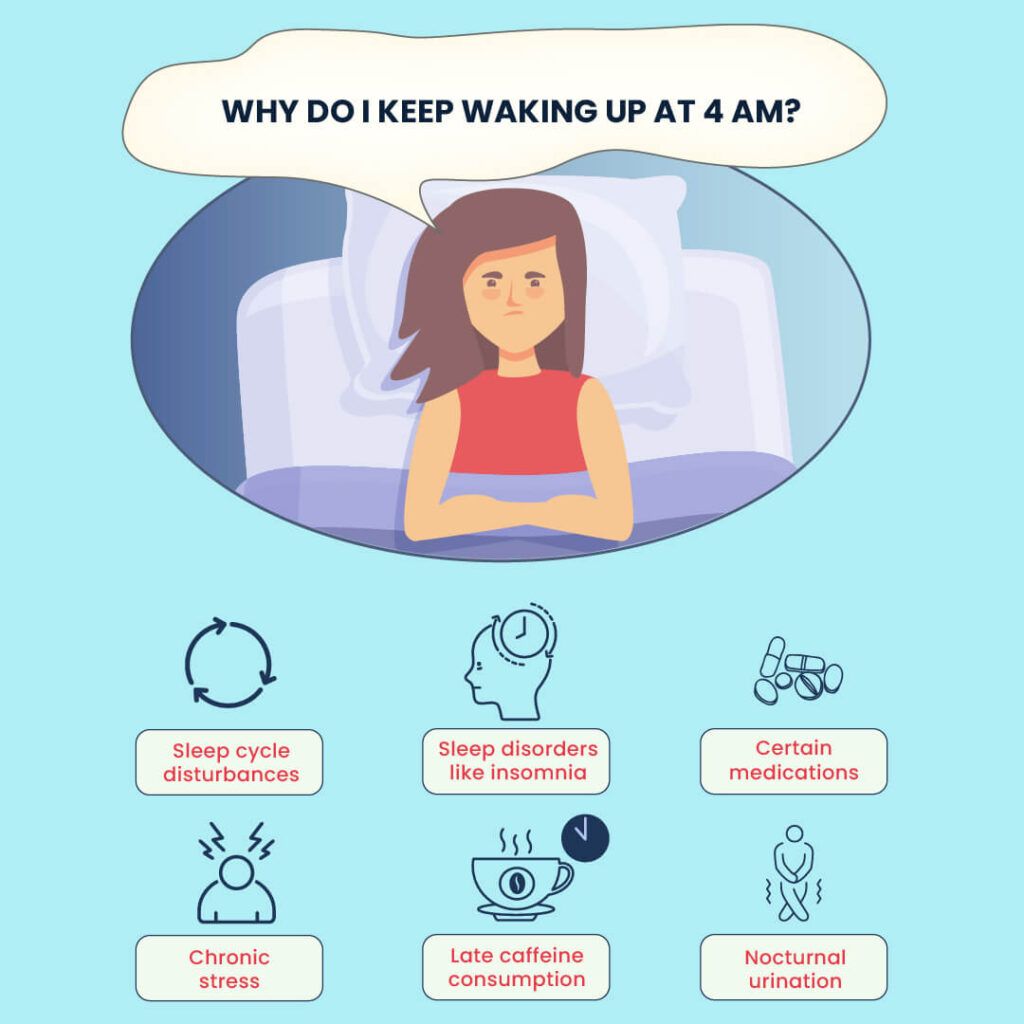
Most of us wake up at least once every night but usually return to sleep immediately.
It’s a normal part of our natural sleep cycle.
With age, sleep patterns change, and the brain adapts.
Consult a doctor if you wake up several times at night and have sleep issues that regularly impact your day.
Waking up at the same time every night or experiencing disturbed sleep can be a byproduct of many sleep aspects, including circadian rhythm and sleep disorders.
No single gene directly determines your likelihood of waking up at 4 AM each night.
Your genetics may still contribute to this issue by influencing several aspects of sleep health.
Did You Know?
Sleep disturbances could strongly affect your well-being.
Diet and lifestyle matter, but it's essential to understand how genes factor in. Learn more:
Here are a few easy-to-follow (some of them well-known) tips to improve your sleep:
If your sleep disturbances are even more profound, try monitoring your sleep habits. Track your daily habits, changes in habits, and the corresponding sleep disturbances or lack thereof.
Once you identify the trigger, you can get management aids that can help you sleep better.
Finally, for problems like insomnia, apnea, hormonal changes, etc., consult a sleep specialist. They may recommend techniques like cognitive behavioral therapy or strategic light exposure to help you sleep better.
At 4 AM, melatonin levels drop, and cortisol levels rise.
Since cortisol is the stress hormone, you may feel stressed or anxious at 4 AM.
A warm bedroom environment is usually the culprit.
Sometimes, medications or medical conditions could affect your body’s temperature regulation.

Can Lack Of Sleep Cause Nausea? Know How To Prevent It

Could Weight Loss Be The Most Effective Treatment For Sleep Apnea?

Is Sleep Meditation For Anxiety Effective?
DNA testing generally doesn't hinder your ability to claim health insurance due to legal protections like GINA and GDPR that keep your genetic information private. While life and disability insurers may sometimes consider genetic risk factors or family history, most health policies focus on current health status. Your genetic data remains secure—read on to learn more about how your rights are protected.
DNA testing, also called genetic testing, helps identify changes in an individual’s genes, chromosomes, and proteins in the body.
This test uses a sample of your blood, hair, skin tissue, or amniotic fluid to help confirm or rule out a genetic condition.
DNA testing also helps determine one’s risk of developing or passing a genetic disorder, health predispositions, and ancestral and lifestyle traits.
DNA testing can be broadly grouped under two categories: Direct-to-consumer (DTC) and medical-grade tests.
These are at-home test kits that help in DNA analysis using a simple saliva or cheek swab sample.
The individual must send the sample to the lab.
Once the lab receives the sample, it provides personalized reports on potential health risks, nutritional status, and even traits related to sleep and skin health.
DTC DNA testing is convenient and offers valuable information at affordable costs.
However, they may not always provide a complete picture of one’s health without the help of a medical practitioner.
These include prenatal testing, diagnostic testing, carrier testing, newborn screening, and preimplantation screening.
DNA testing is a helpful tool for medical professionals and is also increasingly accessible to individuals, giving them valuable insights into their health risks.
However, insurance companies may also consider genetic information to determine insurance premiums and coverage.
Having a genetic marker for a disease does not guarantee the individual will develop a medical illness.
However, an insurer may interpret it as an increased likelihood of a future health condition.
The use of genetic information as a pre-existing condition depends on local laws and policy terms.
Today, with genetic testing becoming increasingly accessible, it is more important than ever to safeguard your genetic information.
Several laws are used globally to keep genetic data private and prevent its unfair use against individuals. Let’s look at them briefly.
Genetic Information Nondiscrimination Act (GINA) is a U.S. law that prevents health insurers and employers from using genetic information to discriminate against individuals.
The General Data Protection Regulation (GDPR) offers strong privacy protections for genetic data in the European Union. It does so by:
The Genetic Non-Discrimination Act (GNDA), enacted in 2017 in Canada, protects individuals from discrimination based on their genetic information.
This law prohibits employers and insurance companies from requesting or requiring genetic testing or information as a condition for providing services, including employment and insurance.
While it protects against discrimination in many areas, it does not cover situations where genetic information is used in cases involving existing health conditions or already present risks.
In Australia, genetic data is considered sensitive personal information under the Privacy Act 1988, and the Australian Privacy Principles (APPs) govern its use.
The law restricts collecting, using, and disclosing sensitive data, including genetic information.
Individuals must consent to using their genetic data, and organizations must take reasonable steps to protect this information.
However, there are exceptions, especially in research or public interest cases.
Australia’s genetic data protections may not extend to the private insurance sector, as insurers sometimes request genetic information for policy underwriting.
In most countries, there are no laws requiring citizens to share their genetic test results, regardless of the type of test.
Some healthcare insurance policies require individuals to share their family history for certain diseases or disabilities.
However, none make it compulsory to share genetic test results.
Even without DNA testing, many insurers evaluate an individual’s risk for health conditions using medical history, routine tests, and family history.
Despite the accessibility to genetic testing, a large section of the population does not willingly opt for it.
This may have to do with several misconceptions shrouding genetic testing.
Here are a few myths!
If you are keen on taking a genetic test, here are a few ways to protect your genetic privacy:
We recommend consulting a genetic counselor after taking a DNA test. They will help you decode your results and evaluate your risks for medical conditions or traits.
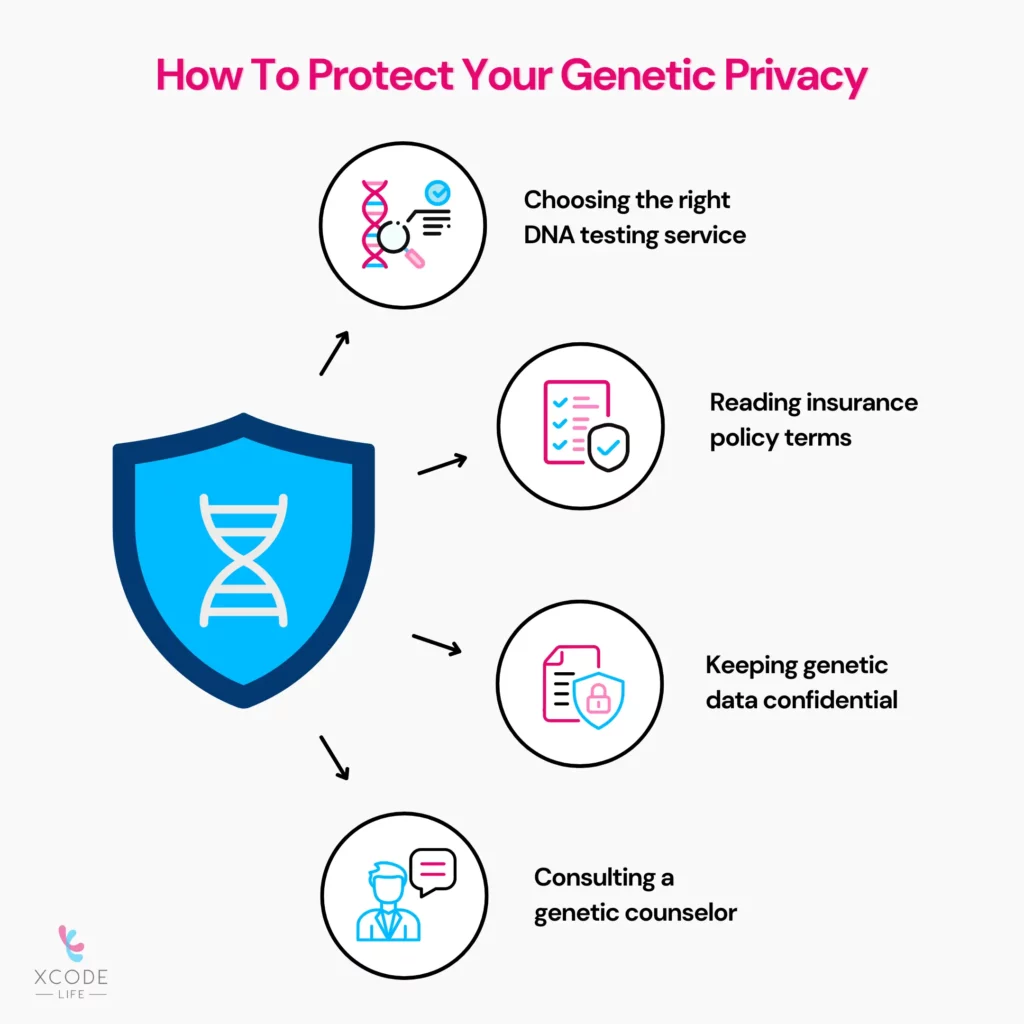
Genetic test results are largely protected and securely stored by most service providers.
You can rest assured that most insurers do not use DNA data against policyholders. Many insurance companies prioritize your actual health status over genetic predispositions.
Laws in several countries, such as GINA and GDPR, safeguard your rights and ensure your genetic information remains secure.
Do not let your fears and prevailing myths influence your wish to get a DNA test.
Genetic testing is an excellent way to stay informed and know more about your health, traits, and lifestyle factors.
In most countries, health insurers cannot use genetic test results to deny coverage or adjust premiums. Laws like GINA (U.S.), GDPR (Europe), and Canada’s Genetic Non-Discrimination Act protect against such discrimination. However, life and disability insurers may consider family history, so checking policy details is important.
Thankfully, insurance companies cannot access your DNA test results without your consent.
However, it is important to read and review the privacy policy of the test company.
Possibly. Unlike health insurance, life and disability insurers can consider genetic risk factors in some regions. Some countries have regulations preventing insurers from using genetic information, but others allow it under certain conditions. Always check with your insurance provider before applying for a policy.
Yes! Most health insurance policies do not factor in genetic test results. For life insurance, the impact depends on the insurer’s policies and country regulations. Discussing concerns with a licensed insurance expert before taking a test is always a good idea.
Not all DNA testing services offer the same level of data protection. Look for companies like Xcode Life that:
It is important to note that not all DNA testing services offer the same level of data protection or privacy.
This is why we recommend you look for companies like Xcode Life that:
The MTHFR gene plays a crucial role in methylation—a biochemical process essential for DNA function, detoxification, and overall health. Mutations in the MTHFR gene, particularly C677T and A1298C, can impact how efficiently the body processes folate and regulates homocysteine levels, potentially influencing health risks such as cardiovascular disease, neurological conditions, and pregnancy complications.
However, having an MTHFR mutation does not automatically mean you will develop health issues. Many individuals with these mutations live normal, healthy lives, and the risks associated with MTHFR variations can often be managed through dietary adjustments, lifestyle changes, and targeted supplementation.
Genetic testing provides actionable insights that empower individuals to make informed health decisions. However, MTHFR testing is not a diagnostic tool—it should be used alongside medical guidance for a holistic approach to health. If you suspect you may have issues related to methylation or elevated homocysteine levels, consult a qualified healthcare provider for personalized recommendations.
By leveraging genetic insights and making evidence-based lifestyle modifications, you can take proactive steps toward optimizing your well-being and preventing potential health risks.
The MTHFR (methylenetetrahydrofolate reductase) gene provides instructions for producing the methylenetetrahydrofolate reductase enzyme.
This gene is crucial for the optimal functioning of the methylation cycle.
The methylation cycle is a crucial biochemical process in our bodies. It involves adding a small chemical group called a methyl group to DNA, proteins, and brain chemicals.
This process plays a significant role in regulating many bodily functions, including gene expression, which determines how genes are turned on or off.
The MTHFR enzyme plays a particular role in converting inactive folate (5,10-methylenetetrahydrofolate) into the active form called 5-methyltetrahydrofolate so the body can use it.
Active folate helps with the conversion of a harmful amino acid called homocysteine to methionine, another amino acid that is safe and useful for the body.
If the MTHFR enzyme doesn’t work well, homocysteine can build up in the body.
This has been associated with several health conditions like:
The MTHFR gene produces an enzyme essential for the methylation cycle, which regulates gene expression and various bodily functions. Proper functioning of this enzyme helps convert inactive folate into its active form, aiding in converting harmful homocysteine into safe methionine. Dysfunctions in MTHFR can lead to elevated homocysteine levels, increasing the risk of health issues like heart disease, cancer, and stroke.
Our DNA looks like a string of letters. The 4 letters (A, T, G, and C), called nucleotides, are organized in a particular way.
For example, position one should be G, position 2 should be A, position 365 should be C, and so on and so forth.
A mutation is any change that occurs in this predefined DNA sequence. It can either affect one letter or a string of letters.

Mutations in the MTHFR gene can result in lower levels of or less functional MTHFR enzyme.
People with MTHFR gene mutations may have high levels of homocysteine and low serum folate levels.
Many mutations occur in the MTHFR gene.
But two of the most common mutations whose effects on enzyme levels and health have been studied are:
| C677T | ||||
| rsID | Major allele | Minor (risk) allele | Normal Amino Acid | Substituted Amino Acid |
| rs1801133 | C | T | Alanine (Ala) | Valine (Val) |
| All enzymes in the body require some heat to function. In the MTHFR gene, at the 677th position, if the C allele is substituted by T, it results in the production of the MTHFR enzyme, which is more sensitive to heat. As a result, it doesn’t bind well to vitamin B2, a co-factor necessary for normal MTHFR functioning. Hence, the C677T mutation results in a less functional MTHFR enzyme. (Ref) |
| A1298C | ||||
| rsID | Major allele | Minor (risk) allele | Normal Amino Acid | Substituted Amino Acid |
| rs1801131 | A | C | Glutamate (Glu) | Alanine (Ala) |
| Those with the C allele exhibit reduced activity of the MTHFR enzyme; there’s no clear mechanism explaining this reduction. The effect of A1982C on homocysteine levels is still unclear. (Ref) |
MTHFR gene mutations, particularly the C677T and A1298C variants, are relatively common across various populations worldwide.
We all inherit two copies of the MTHFR gene, one from each biological parent. So, you can have the following possible combinations:
| C677T | ||
| TT | ~80% reduced MTHFR enzyme activity | High risk for higher homocysteine levels |
| CT | ~35% reduced MTHFR enzyme activity | Moderately high risk for higher homocysteine levels |
| CC | Normal enzyme activity | Likely normal homocysteine levels |
| A1298C | ||
| CC | Reduced MTHFR enzyme activity | Moderately high risk for higher homocysteine levels |
| AC | Moderately reduced MTHFR enzyme activity | Moderately high risk for higher homocysteine levels |
| AA | Normal enzyme activity | Likely normal homocysteine levels |
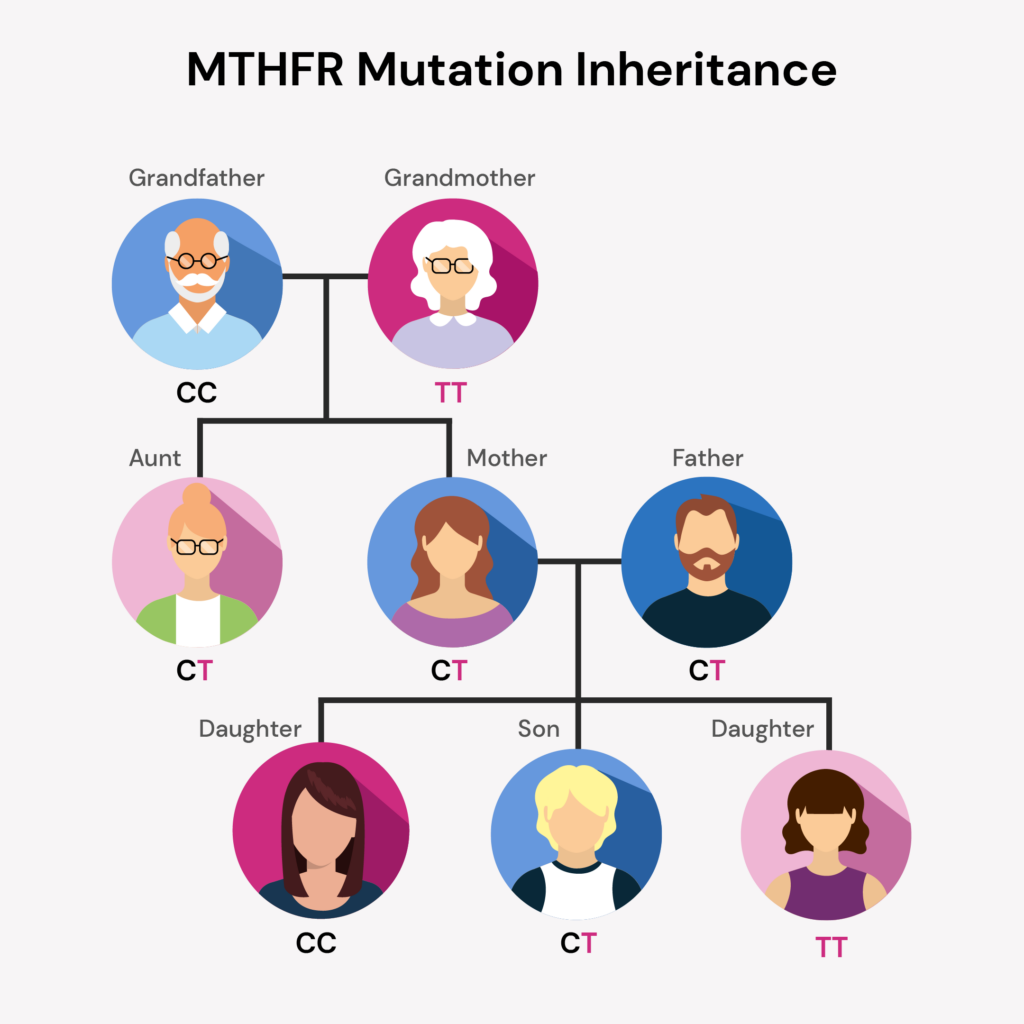
MTHFR gene mutations may lead to vitamin deficiencies, especially vitamin B9, and increased homocysteine levels.
Both of these can increase the risk for several health conditions.
A large meta-analysis involving over 40 studies found that individuals with the TT genotype (C677T mutation) have a higher risk of developing cardiovascular diseases due to elevated homocysteine levels, which is a known risk factor for heart disease and stroke.
When the body doesn’t have enough folate or the enzymes responsible for processing folate don’t work efficiently, it can disrupt an important process called the remethylation pathway.
This pathway helps keep homocysteine levels in check. If folate levels are low or the enzymes are not working properly, homocysteine builds up in the blood.
High homocysteine levels have been linked to an increased risk of certain cancers.
Folate is crucial for proper cell division and development during pregnancy.
Insufficient levels may disrupt the normal processes that help close the neural tube in a developing fetus, increasing the likelihood of NTDs.
Therefore, females with this genetic variant may need to ensure adequate folate intake, especially during the early stages of pregnancy, to help mitigate the risk of NTDs.
MTHFR enzyme helps convert homocysteine to methionine.
Our bodies then use methionine to help produce brain chemicals like dopamine and serotonin.
These brain chemicals, also called neurotransmitters, need to be at optimal levels for normal brain functioning.
Mutations in the MTHFR gene may disrupt the neurotransmitter imbalance. This can result in an increased risk of an array of conditions like:
Vitamin B12 deficiency, improper folate metabolism and homocysteine imbalance are common with MTHFR mutations.
They have been identified to play a role in the pathology of several autoimmune diseases, including psoriasis, multiple sclerosis, Behcet's disease, ankylosing spondylitis, and Graves' disease.
This could be due to:
Scientists are still researching the possible symptoms of MTHFR gene mutations.
These are some common symptoms that seem to affect many people with this condition.
Some signs and symptoms of those with MTHFR gene mutations include
Mutations in the MTHFR gene can affect children in various ways.
Common symptoms include:
MTHFR mutations are detected through genetic testing, which analyzes variations in the MTHFR gene—primarily C677T and A1298C.
These mutations can impact folate metabolism, methylation, and homocysteine levels, influencing overall health.
*MTHFR testing is not a diagnostic tool and should not be used to self-diagnose medical conditions. While certain genetic variations may influence methylation and folate metabolism, they do not necessarily lead to health issues. If you are experiencing persistent symptoms or have concerns about your genetic health, consult a qualified healthcare professional for proper evaluation, guidance, and personalized recommendations.
MTHFR testing is available through:
Understanding your MTHFR report is key to making informed decisions about your health and wellness.
Let’s break down the contents of a typically delivered MTHFR report.
Most services analyze the 2 main variants in the MTHFR gene: C677T and A1298C.
| Possible Results | ||
| Normal | No mutations detected | Likely no effect |
| C677T Heterozygous | One copy of the variant allele - CT | Moderately lower folate levels and higher homocysteine levels |
| C677T Homozygous | Two copies of the variant allele - TT | Lower folate levels and higher homocysteine levels - associated health risks |
| A1298C Heterozygous | One copy of the variant allele - AC | Moderately lower folate levels and higher homocysteine levels |
| A1298C Homozygous | Two copies of the variant allele - CC | Lower folate levels and higher homocysteine levels |
| Compound Heterozygous | One copy of each mutation - C677T: CT and A1298C: AC | Lower folate levels and higher homocysteine levels |
While MTHFR is an important gene in the methylation cycle, there are also other genes that are a part of the normal methylation process.
That’s why Xcode Life has developed the industry’s most comprehensive methylation panel with 15 genes and 64 variants, including MTHFR, MTRR, MTR, COMT, and AHCY.
You can simply upload your raw DNA file from ancestry tests provided by companies like 23andMe, Ancestry DNA, FTDNA, and My Heritage to get your reports in <24 hours.
Adopting targeted lifestyle changes can help manage the effects of MTHFR mutations, support healthy methylation, and reduce associated health risks.
Below are evidence-based strategies to optimize your diet, supplements, and daily habits.
Foods to eat:
Foods to avoid:
Since MTHFR mutations affect the way the body processes certain vitamins, one of the important ways of handling the condition is nutritional supplementation.
Folate vs. Folic Acid For MTHFR
Folate is the naturally occurring form of vitamin B9, and folic acid is the synthetic form added to fortified foods and supplements.
Individuals with MTHFR mutations have a reduced ability to convert folic acid into its active form, 5-methyltetrahydrofolate (5-MTHF), which is the form the body can readily use.
Research indicates that 5-MTHF increases plasma folate more effectively than folic acid, regardless of MTHFR mutations.
Magnesium: While the MTHFR mutation does not cause magnesium deficiency, this mineral may help reduce cardiovascular risk in people with this gene mutation.
It is not advisable to start any supplements without consulting a qualified medical practitioner. Not everyone with MTHFR mutations may require supplementation, as individual health needs can vary significantly. A healthcare professional can provide guidance based on your unique circumstances and health profile. Always prioritize professional guidance when considering dietary changes or supplementation related to MTHFR mutations.
Environmental toxins, heavy metals, and pollutants can significantly impact the body's methylation processes, particularly in individuals with MTHFR gene variations.
According to a 2021 study, exposure to metals like manganese, arsenic, lead, mercury, nickel and cadmium can lead to epigenetic modifications, including DNA methylation. These epigenetic alterations may contribute to the development of neurodegenerative diseases such as Alzheimer's, Parkinson's, and Huntington's disease.
A metapredictive analysis revealed that air pollution level was significantly associated with MTHFR 677 TT polymorphism-mutation and an increased trend toward breast cancer risk.
The MTHFR enzyme is thermolabile (deactivated by heat) and its activity may be further reduced in individuals with polymorphisms as environmental temperatures rise due to global warming exacerbated by air pollution.
Air pollutants potentially affect MTHFR gene expression through genotoxicity and epigenetic modifications, leading to changes in DNA methylation patterns.
This interaction between genetic factors (MTHFR polymorphisms) and environmental exposures (air pollution) appears to influence breast cancer susceptibility.
The associated risk and polymorphism rate varies by geography.
Heavy metals such as lead, mercury, cadmium, and arsenic are particularly harmful to individuals with MTHFR mutations.
These metals can interfere with enzymatic processes critical for detoxification and methylation.
They may bind to enzymes or disrupt cellular functions, leading to an accumulation of toxins in the body.
This accumulation can further impair the already compromised detoxification pathways associated with MTHFR mutations.
Elevated levels of heavy metals have been linked to increased susceptibility to autoimmune conditions and chronic diseases.
However, while some studies suggest that people with MTHFR mutations might be more vulnerable to these toxins, this remains an area of active research and should be interpreted cautiously.
To support detoxification pathways in the presence of MTHFR mutations, consider the following strategies:
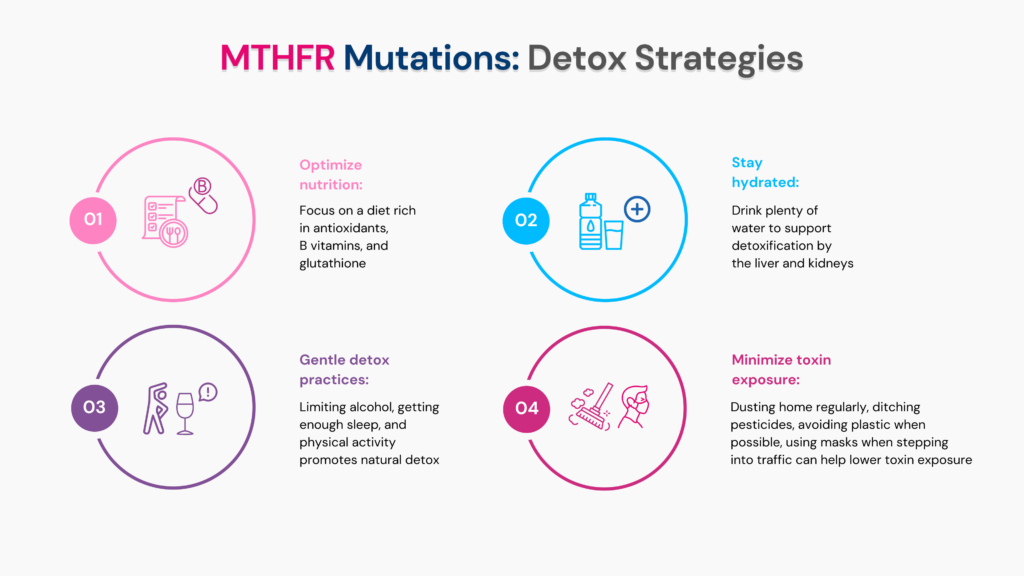
Managing MTHFR mutations effectively requires a personalized approach that considers individual genetic profiles, lifestyle factors, and health goals.
The first step in personalized MTHFR management is to understand your specific genetic variations.
Genetic testing can reveal whether you have common mutations such as C677T or A1298C, which can influence how your body processes folate and regulates homocysteine levels.
Other than MTHFR, several genes like MTR, MTRR, COMT, and AHCY affect the methylation process. So, they need to be included in the test as well.
Based on your methylation status, dietary recommendations can be tailored to include foods rich in natural folate and other B vitamins that support methylation.
Avoiding synthetic folic acid in favor of methylfolate may also be advised.
While some individuals may benefit from supplements like methylated folate or B vitamins, others may not require additional supplementation.
In some cases, additional supplementation with vitamin D or NAC may be required.
A healthcare provider can help determine the right approach based on your unique needs and health status.
Along with this growing interest in MTHFR, there's a wave of misinformation that can easily lead to confusion and unnecessary worry.
Here are some common misconceptions surrounding MTHFR and Methylation
Fact: MTHFR isn't the only gene associated with homocystinuria.
In fact, another gene called CBS has a stronger association.
Only extreme situations lead to a full-blown mutation, and the detection of an MTHFR variant on a report isn’t necessarily a cause for concern.
Fact: While it’s true that a mutated MTHFR enzyme can’t act upon folates effectively, it’s also important to understand that your body has other ways of handling folates.
The folate level in your blood is more dependent on your folate intake than your MTHFR mutation.
Fact: Birthmarks like stork bites, sugar bugs, and sacral dimples could spook parents into worrying about the health of their infants.
However, they aren’t a cause for concern since they fade away as time passes.
Additionally, no studies have been published that show any correlation between these birthmarks and the adverse effects of the MTHFR mutation.
Fact: In most cases, no. Even a double C677T mutation only lowers folic acid levels by 16%.
Folic acid levels also depend on various factors like diet and environmental exposure.
If the labs don’t indicate a severe deficiency, adding extra vitamin B9-rich foods to your diet should do the trick.
Xcode Life offers a comprehensive MTHFR test that provides insights into the methylenetetrahydrofolate reductase (MTHFR) gene, which is crucial for understanding methylation processes in the body.
Unlike many other services, Xcode Life’s report also includes insights into 14 other methylation genes, including MTR, MTRR, COMT, and AHCY and 66 genetic variants.
Further, it is available at an industry's lowest price of $50 $30.
Xcode Life distinguishes itself by allowing users to upload raw genetic data from other testing services, enabling a more detailed analysis of their genetic predispositions and health risks.
Xcode Life prioritizes user privacy, ensuring that personal data is secure and not shared with third parties.
By choosing Xcode Life for MTHFR testing, individuals can gain valuable insights into their genetic health, enabling them to take proactive steps toward optimizing their well-being.
Genetic testing is a very important piece that completes the health puzzle.
We have over 20,000 genes and millions of variants in these genes, each exerting its effect on the body - either singularly or in combination.
While the effects of some variants are immediately visible - like eye color or hair texture - many effects, like disease risk, nutrient deficiencies, and food allergies, may not be apparent.
A genetic test throws light on all these traits, helping us see the whole picture of health.
It helps us make informed decisions to alleviate health risks and even prevent certain chronic conditions.
The significance of MTHFR mutations can vary widely among individuals. Many people with MTHFR mutations live healthy lives without any noticeable symptoms or health risks.
However, these mutations can be a risk factor for folate deficiency, which may lead to various health issues if left untreated.
Dr. Graham Dersnah, an Obstetrics & Gynecology (OBGYN) chief resident, explains in a video on his YouTube channel that untreated folate deficiency in pregnant people can increase the risk of neural tube defects in the baby.
These defects affect the spinal cord and the nervous system with varying severity.
He also mentions that even in those who are not pregnant, folate deficiency can lead to anemia, fatigue, weakness, glossitis (swelling of the tongue), and diarrhea.
Absolutely, many individuals with MTHFR mutations lead normal, healthy lives.
While some may experience health challenges related to elevated homocysteine levels, lifestyle modifications such as a balanced diet rich in folate and appropriate supplementation can mitigate these risks.
Regular monitoring and working with healthcare providers can also help manage any potential complications.
Individuals with MTHFR mutations should be mindful of their diet.
Refined grains and fortified foods contain the synthetic form of folate, which individuals with MTHFR deficiency may struggle to process.
It is advisable to limit processed foods and those high in refined carbohydrates, as they may contribute to inflammation.
Alcohol can increase oxidative stress on the body and interfere with folate and vitamin B absorption.
So, it is best to limit alcohol consumption if you have MTHFR mutations.
Currently, there is no way to reverse an MTHFR mutation itself, as it is a genetic change.
However, its effects can be managed through dietary adjustments, lifestyle changes, and supplementation with B vitamins (particularly folate) to help lower homocysteine levels.
Consulting with a healthcare professional can provide personalized strategies for managing the implications of an MTHFR mutation.
Understanding your MTHFR status offers a window into how your body processes vital nutrients and manages detoxification, helping you pinpoint areas for improvement. While a mutation doesn't seal your health fate, it does highlight where targeted dietary and lifestyle changes can make a real difference. Xcode Life’s industry-best and comprehensive MTHFR and Methylation Report provides insights into 15 methylation genes to optimize your well-being. Ready to take a proactive step toward personalized health? Upload your raw DNA and get your report today!
Ever feel like you're working hard at the gym but not seeing the results you want? Or maybe you're just starting out and don't know where to begin. Your genes might hold some of the answers. DNA fitness tests can reveal how your body is wired for exercise and diet, helping you train smarter, not harder. They offer a peek into your genetic makeup, helping you tailor your training and nutrition for better results.
DNA testing for fitness analyzes specific genes linked to your physical fitness.
The test is usually done by collecting a sample of your saliva or a swab of your cheek.
You can receive personalized diet and exercise recommendations based on your genetic profile based on your genetic profile.
DNA testing for fitness can provide insights into your aerobic capacity, muscle fiber type, recovery time, nutritional needs, and more.
Genetic factors can account for 30 to 80 % of the variation among individuals regarding athletic performance.
The ACTN3 gene codes for alpha-actinin-3, a protein found in fast-twitch muscle fibers. Variations in this gene can influence muscle composition in individuals, impacting performance and fitness levels.
Several other genetic markers, such as the BDNF, TP53, and GRIN2B genes, can influence one's body's endurance, recovery, and injury risk.
DNA tests can provide a personalized approach to fitness by identifying these genetic markers.
Skeletal muscle is an important factor that affects fitness and athletic performance.
There are two types of muscle fibers in the skeletal muscles: slow-twitch muscle fibers and fast-twitch muscle fibers.
Slow-twitch muscle fibers take longer to contract but can keep working without tiring for a long time.
On the other hand, fast-twitch muscle fibers contract quickly and get tired easily.
Slow-twitch muscles enable endurance activities, while fast-twitch muscle fibers help in sprinting and other activities that need strength.
Some people can have more slow-twitch muscle fibers, while others can have more fast-twitch muscle fibers.
Apart from muscle composition, these are some other key factors where genetics can influence your fitness levels:
Based on the results of your DNA fitness test, it is possible to fine-tune your workout to achieve the best possible results. Below are some avenues that can be optimized using your DNA test results:
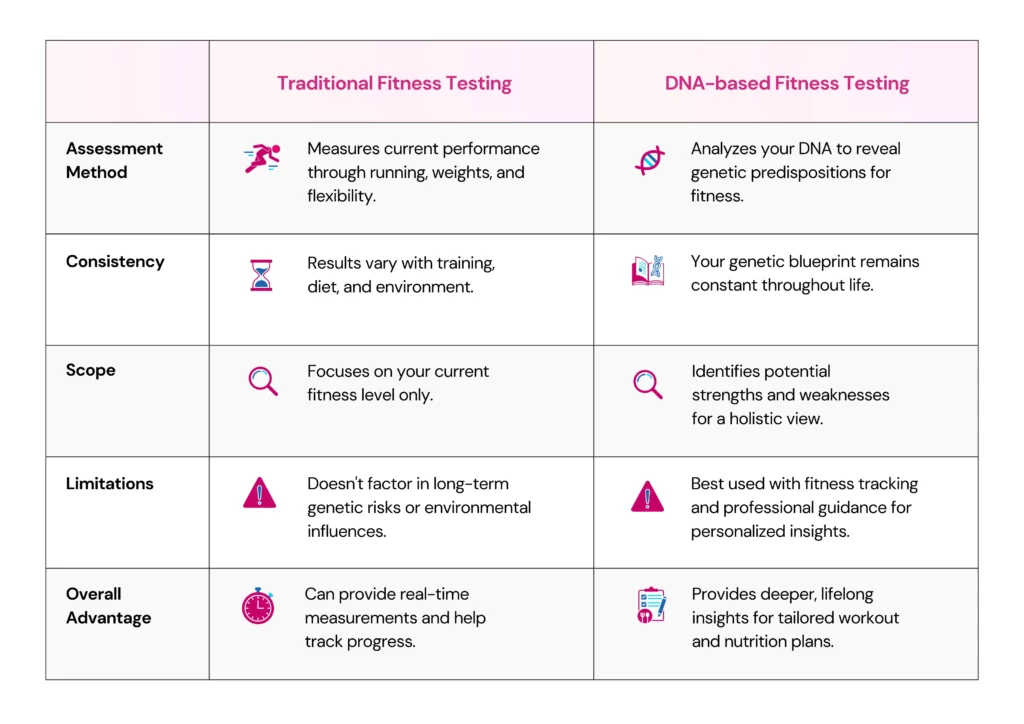
Science-backed fitness insights curated by experts to bring you the latest research findings on sports genetics.
Strength or cardio? Shorter or longer rest periods? How to sidestep sports injuries? Do I have optimal VO2 max? Is my cardiac output up to par?
Answers to these and more on your Gene Fitness Report.
Here are a few things to keep in mind before choosing a DNA fitness test:
Here are some popular DNA fitness tests:
| Comparing Different DNA Fitness Testing Companies | |||||
| Company | Price | Number of genes analyzed | Turnaround Time (TAT) | DNA Kit Provided? | Sample Report |
| Xcode Life | $30 (industry lowest) | 162 | < 24 hours | No new kit needed – upload raw DNA data from services like 23andMe, Ancestry, etc. | Gene Fitness |
| Genetrack Biolab | $249 | 16-20 | Not specified (could be 4-6 weeks) | Yes – sample collection kit provided | Not provided |
| Dynamic DNA Laboratories | $149 | N/A | Not specified (could be 4-6 weeks) | Yes – sample collection kit provided | Not provided |
Your genes influence your fitness and athletic performance.
DNA testing can help you identify these genetic variations and better understand what works for you.
It can help you have a more personalized and nuanced approach to fitness.
However, genetics are only one piece of the puzzle.
Your fitness levels also depend on lifestyle, training, and diet.
A combination of genetic testing, along with a healthy diet and lifestyle, will maximize your fitness potential.
Explore Xcode Life's fitness DNA test to personalize your workout journey.
Our DNA test is easy to use and profiles genes that influence endurance, performance, aerobic capacity, power, strength, and other fitness attributes.
DNA tests can provide valuable insights into your genetic predispositions.
They can tell you about your muscle composition, endurance, and aerobic capacity.
Based on these parameters and under the guidance of a professional, you can create a personalized workout regimen that best suits your body.
Such a routine will help you determine whether you are more suited to cardio or strength training, how much recovery time you need, and how you can prevent injuries.
However, genetics is just part of the picture.
Your diet, training, and lifestyle all greatly influence your fitness levels.
Combining your genetic test results with a healthy diet and lifestyle will help you achieve optimum results and meet your fitness goals.
Fitness DNA tests can provide accurate data about your genetics and help you understand how they impact your health.
However, these tests cannot guarantee you specific results.
Fitness and athleticism depend as much on your environment and diet as genetics.
While DNA tests can predict your biological inclinations, your fitness levels ultimately depend on your overall lifestyle.
There are no scientific studies to show that DNA testing can help you lose weight and become more fit.
There seems to be no difference in weight loss between people who follow a standard diet and those who follow a diet based on their genotype.
There are no downsides to fitness DNA testing from a health point of view.
However, these tests can give complex results that might be difficult for laypeople to interpret.
This can result in misinterpretation and inappropriate training and dietary choices.
Overemphasizing genetic test results also misses the bigger picture.
Your fitness levels are impacted by diet and lifestyle apart from genetics.
Focusing on genetics alone can result in a false sense of determinism.
https://pmc.ncbi.nlm.nih.gov/articles/PMC3993978
Photographic memory is a rare and mysterious cognitive ability that allows people to remember images and objects in detail. It’s a rare phenomenon in which someone can retain an enormous quantity of information, whether it be images, sounds, or words. Photographic memory was first documented by a Harvard vision scientist named Charles Stromeyer III in early 1970 about a student named Elizabeth. Some believe that photographic memory is a real phenomenon, while others believe it’s just an exaggeration or myth. Another school of thought is that photographic memory could be genetic, where having a few gene changes may help retain information better. This article explores whether there is such a thing as photographic memory and the genetic landscape of it.
Why do we remember some things more distinctly than others? And why do some memories fade?
Answering these questions requires us to look into how memories are formed in the first place.
Our daily experiences are converted into pulses of energy that travel along the neuron network and form short-term memories first.
These are available for a few seconds or a few minutes.
They then get converted into long-term memories through certain brain areas like the hippocampus.
Finally, they reach the storage regions present in the brain.
With the help of brain chemicals called neurotransmitters, neurons communicate with each other in regions called synapses.
Continuous communication between two neurons increases efficiency, a process described as long-term potentiation.
This phenomenon helps store long-term memory.
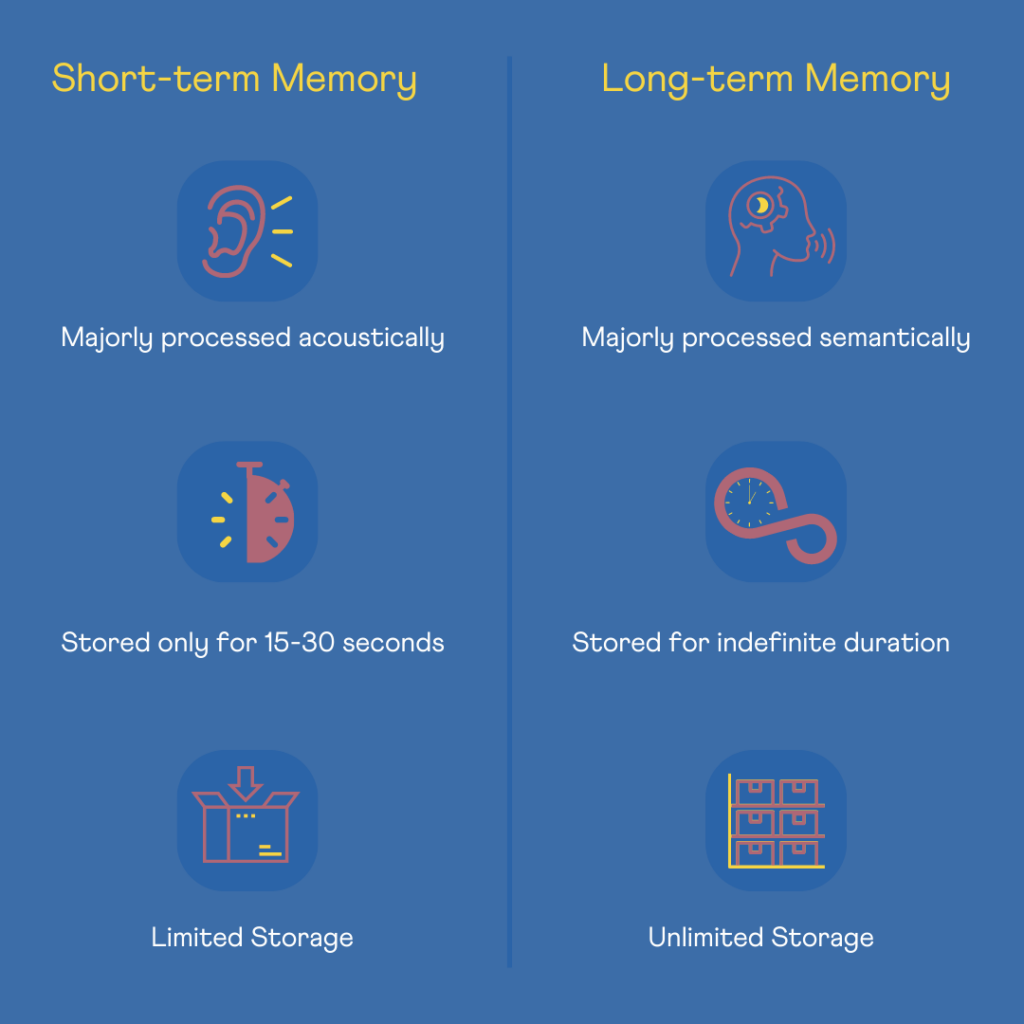
While ongoing research indicates that some may be genetically "blessed" with greater memory and recall powers, there's no concrete evidence that suggests photographic memory is genetic.
The common impression of photographic memory is that some people can take a mental snapshot of whatever is in front of them and retrieve it from memory, zooming in and out of various parts.
However, the true existence of photographic memory has not been proven till now.
What people mostly refer to as photographic memory is, in fact, eidetic memory.
Eidetic memory is “the ability to recall an image from memory with high precision for a brief period after seeing it only once, and without using a mnemonic device.”
This memory lasts less than one second for most people and a few seconds for others.
Genetic Influences On Memory
*Dopamine is a neurotransmitter linked with learning and memory
Episodic memory is the ability to recall and mentally re-experience specific episodes from one's past.
Despite these findings, true photographic memory is extremely rare and not fully understood.
Most cases of exceptional memory, such as those seen in individuals with hyperthymesia (highly superior autobiographical memory), do not necessarily equate to photographic memory.
For instance, Jill Price, known for her remarkable memory, can recall detailed personal experiences but does not possess photographic memory in the traditional sense.
Memories also depend on other lifestyle and environmental factors like diet and educational attainment.
As we age, the synapses become weak, making it difficult to retrieve information.
According to studies, the hippocampus loses 5% of its neurons every decade after age 40, resulting in a 20% loss by 80 years.
There may also be a loss of neurotransmitters.
Other mental and physical health conditions associated with aging can also be why memories get lost.
Chronic stress is another major contributor to memory issues.
The body releases a surge of hormones, enabling us to wave through stressful situations.
However, chronic stress continually exposes the body to this flood of hormones.
This may result in the loss of brain cells and block the formation of new ones, making it difficult to retain information.
Depression is another condition associated with memory problems.
The low levels of serotonin seen in individuals with depression can make it difficult for a person to pay attention to new information.
People with depression may be 40% more likely to develop memory and cognition-associated problems.

How Does Anxiety Affect Your Brain?

Top 7 Vitamins and Nutrients For Clearing Brain Fog

NMN Benefits: The Top 7 You Need To Know In 2024
https://www.ncbi.nlm.nih.gov/pmc/articles/PMC2596698/
https://www.eurekalert.org/news-releases/644739
https://en.wikipedia.org/wiki/Eidetic_memory
The future of healthcare is personalized and preventive, not standard and reactive.
Preventive health aims to catch early signs of risk and make lifestyle changes to reduce disease likelihood.
Genetic testing plays a crucial role in identifying predispositions before symptoms arise through personalized, science-backed insights.
These insights include inherited risks for conditions like heart disease, diabetes, cancer, and neurological disorders.
Genetic variations can also affect metabolism, nutrient absorption, drug response, and fitness levels.
Choosing Xcode Life’s genetic wellness reports could be your first step toward better health.
With the advances in science and medicine, lifespans have increased today compared to the previous generations. However, we see more people living with chronic conditions. Wouldn’t it be a relief to know what diseases you are prone to before you develop them? Well, this is possible with genomics and preventive health care.
The traditional approach to healthcare has always focused on treating an illness after it appears. However, the shift to preventive healthcare helps doctors spot early signs of risks and recommend lifestyle changes to reduce the likelihood of the individual developing the condition.
Genetics is crucial in identifying an individual’s predisposition to diseases before signs or symptoms appear.
Your genes carry the information about how your body should function.
These genes are in your DNA, which holds key insights into your risk for inherited conditions like diabetes, heart disease, cancer, and neurological conditions.
Genetic variations can affect your metabolism, nutrient absorption, response to different drugs, and overall fitness levels.
Understanding your unique genetic blueprint can help you take a proactive, personalized approach to wellness. Under a doctor’s guidance, you can optimize your diet, exercise routine, and healthcare choices to effectively reduce potential health risks.
Genetic testing can reveal deep insights into various aspects of your health and potential risk for illnesses:
Identifying genetic predispositions to chronic illnesses like cardiovascular diseases, Alzheimer’s, and diabetes helps you stay ahead of the curve,
A 2017 study suggests that genetic risks heavily influence chronic conditions.
These risks can be measured using polygenic risk scores (PRS), the statistical calculation that estimates a person’s risk for developing a medical condition.
The onset and severity of chronic conditions can affect an individual's general health, cognition, mobility, and psychosocial health.
Genetics influence nutrient absorption, deficiencies, and dietary requirements.
Genetics can overlap with nutrition, giving rise to a new field called nutritional genomics.
With regard to nutrition, genetics is known to influence the following aspects:
Genetic variations may also be linked to an individual’s food likes and dislikes.
For example, phenylthiocarbamide (PTC) found in vegetables like cabbage, cauliflower, kale, and Brussels sprouts can taste very bitter or almost tasteless, depending on an individual’s genetic makeup.
The gene TAS2R38 was responsible for a person’s ability to taste PTC.
Genes also influence:
However, gene-diet interactions are complex, and more research is required to understand and implement nutritional genomics more effectively.
Learning how genes determine responses to medications can help avoid adverse reactions.
Do all medications affect all individuals alike? Not really!
While the primary goal of medications in treating an illness is curing it, severe adverse drug reactions can become a major concern in clinical practice.
For example, Shobana et al. found an association between HLA-B*57:01, HLA-B*55:01, CYP2C9*3, and phenytoin-induced cutaneous adverse drug reactions in the South Indian Tamil population.
Identifying genetic variations associated with adverse drug reactions can help medical professionals personalize medicine and develop sustainable health systems.
Tailoring workouts based on genetic factors like endurance, muscle composition, and recovery time can significantly optimize your workout journey.
Here are some key areas where preventive health through genetics can influence fitness:
Some people are genetically predisposed to have more slow-twitch muscle fibers.
This makes them better suited for endurance activities like running or cycling.
People with more fast-twitched fibers are stronger and better at activities like weightlifting and sprinting.
Your maximum oxygen uptake is an indicator of cardiovascular fitness.
Some genetic variants affect how your body uses oxygen during exercise, determining your stamina and endurance levels.
This is the point during exercise when lactic acid builds up in the muscles, causing fatigue.
Genetic testing can help you identify how your body processes lactate and whether you are genetically predisposed to fatigue earlier or later than others.
Genes influence how your body metabolizes nutrients like fats, carbohydrates, and proteins.
Knowing this can help you adjust your diet to fuel your workouts and improve performance.
Some people are more prone to injuries like tendonitis, ligament tears, and stress fractures, thanks to their genes!
Understanding your genetic susceptibility to an injury can help you choose exercises that reduce your risk of falls or trauma and strengthen vulnerable areas simultaneously.
How genetic variations impact detoxification, cardiovascular health, and mental well-being.
Methylenetetrahydrofolate reductase (MTHFR) is an enzyme that breaks down the amino acid homocysteine.
When an abnormal change or mutation occurs in the MTHFR gene, which codes for the enzyme with the same name, it may affect how the body detoxifies substances.
This gives rise to chronic health conditions– from cancer to cardiovascular diseases, depression, and other mental health conditions.
Two common variants of the MTHFR gene are C677T and A1298C.
Both these variants are known to cause high homocysteine levels in the blood, increasing the risk for health conditions like birth anomalies and coronary heart disease.
Preventive genetic testing can help determine your risk for serious illnesses like cancer, Alzheimer’s, type 2 diabetes, etc.
Specific mutations in the BRCA1 and BRCA2 genes could put you at an increased risk for breast and ovarian cancers.
Individuals with specific mutations in their APOE gene have been found to have a stronger association with the development of Alzheimer’s.
By analyzing an individual’s DNA, medical professionals can get a deeper insight into the genetic profiles.
This helps them personalize treatments for specific conditions.
Medical professionals can use targeted therapies and optimize medication response using the information from genetic testing.
Personalized medicine ensures the right medications are prescribed at the right dosages, reducing side effects and enhancing efficacy.
Personalized medicine can be applied to areas like reproductive health and fertility.
Many couples struggle with conception and rarely go beyond the primary diagnosis.
However, using advanced genetic testing, doctors can now assess the reasons for infertility and assess any hereditary risks for future generations.
Couples can get valuable insights about the best options they have to fulfill their dream of parenthood.
In addition to this, couples can also opt for preimplantation genetic testing (in the cases of IVF procedures) and genetic testing of the fetus to know about its genetic health.
Genetic testing is a powerful tool for patient empowerment and gives peace of mind.
When individuals are aware of their predisposition to certain medical conditions, they take more precautions to reduce their risks.
Knowing about their genetic risks also prepares individuals financially and psychologically rather than being caught off-guard.
Despite the many benefits of knowing about genetics and what’s ‘written in your DNA,’ it is not your destiny.
While your genes reveal your predisposition, other factors, such as lifestyle, environment, habits, and stress, play a crucial role in the outcomes.
Every time a genetic test is available, it does raise certain questions like–
The answer to these questions is essential because several ethical, legal, and social issues have been associated with genetic testing and research.
Medical professionals and genetic experts (geneticists) must clearly communicate with the test takes that most genetic tests provide simple positive/negative tests.
Xcode Life’s comprehensive genetic test reports explore several facets of your health and wellness, including:
At Xcode Life, you can rest assured of data security and privacy, as confidentiality lies at the core of our offerings.
If you are looking to undergo genetic testing, Xcode Life provides easy-to-understand reports.
These reports help users make informed decisions about their health and adopt necessary lifestyle changes.
Traditionally, healthcare has been curative.
However, with newer technologies like genetic testing and personalized medicine, the future of healthcare is undoubtedly preventive.
Genetic testing makes individuals aware of their predisposition to various medical conditions and empowers them to take control of their health.
This is possible with science-based insights combining genetic, environmental, and lifestyle factors.
Learn more about your health with Xcode Life’s genetic wellness reports here.
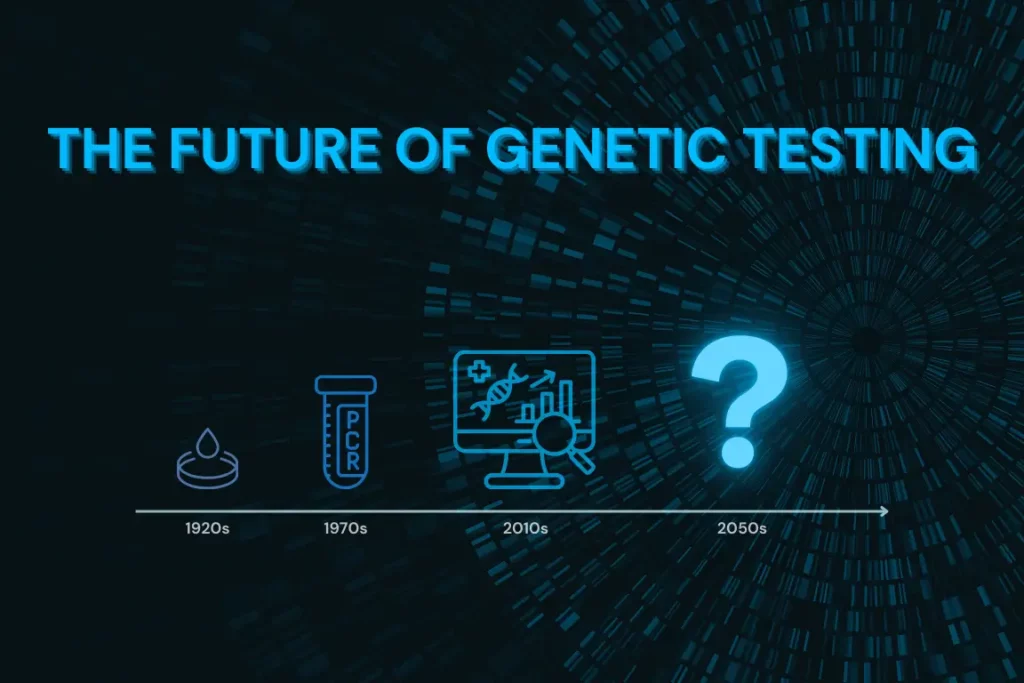
The Future Of Genetic Testing: Emerging Trends And Innovations
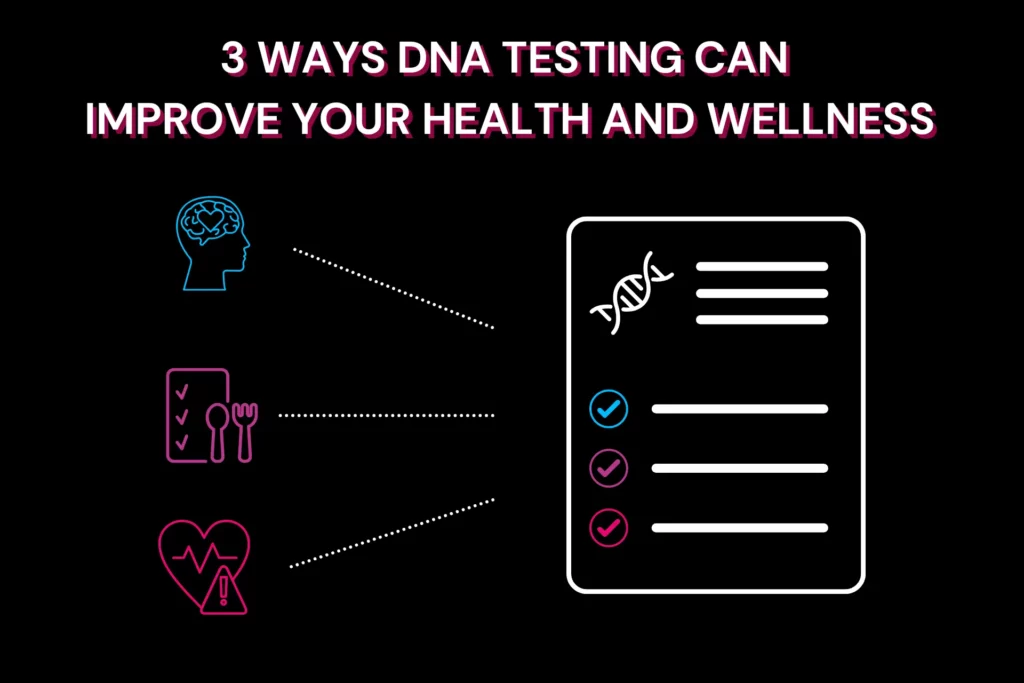
3 Ways DNA Testing Can Improve Your Health And Wellness
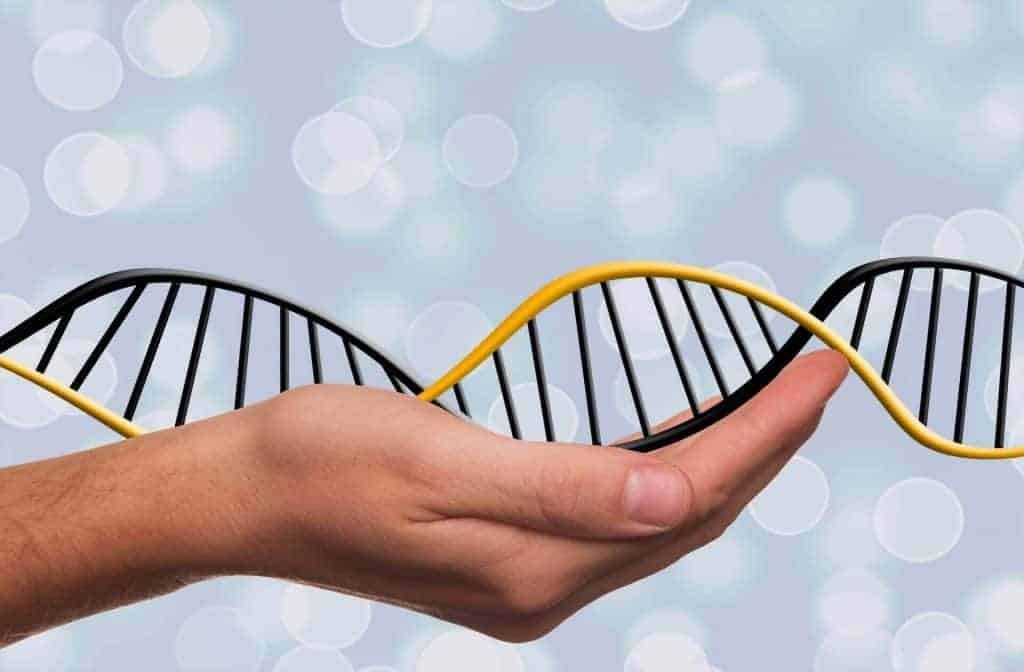
How Much Is A DNA Test - A 2025 Guide